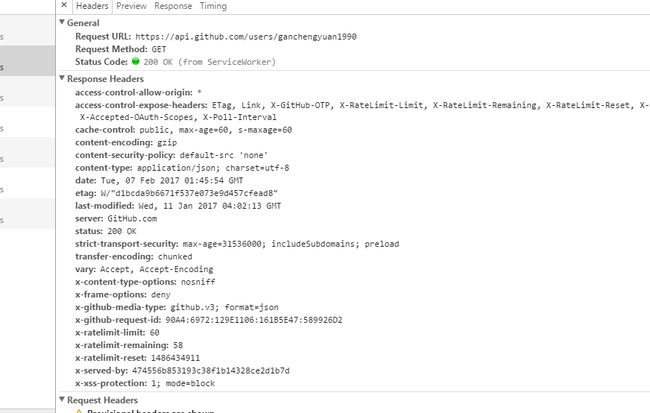白屏以及离线不可用,是Web App最大的体验问题。据说,PWA是解决这两大问题的曙光。
那么,就很有必要来了解试用一下这玩意儿。
OK, 程序员的好习惯之一是使用Github,搜索"pwa demo"
按照md来进行安装和部署之后,按照要求来试玩(因为下载不到chrome canary版本,暂用普通的Chrome来测试):
Step 1: Go offline.(切离线环境)
Step 2: Register BG Sync from above register button.(点击页面上注册按钮)
Step 3: Enter a git username and click add.(输入github用户名)
Step 4: Go online and sync will be triggered when user is gets connectivity and card will be updated.(切上线环境以后刷新)
试用以后并不能work.
因此简单修改步骤:
Step 1: 线上环境首先搜索一个github用户名。
Step 2: 获得结果以后切离线环境。
Step 3: 点击注册按钮。
Step 4: 离线环境下搜索同一个用户名,正常来说无法访问,但是同样可以获得正确结果。
为何如此神奇呢?
上图是HTTP Response头部信息,看起来这个serviceWorker是重点
先看一段定义
一个 service worker 是一段运行在浏览器后台进程里的脚本,它独立于当前页面,提供了那些不需要与web页面交互的功能在网页背后悄悄执行的能力。在将来,基于它可以实现消息推送,静默更新以及地理围栏等服务,但是目前它首先要具备的功能是拦截和处理网络请求,包括可编程的响应缓存管理。
接着看代码:
//Adding `fetch` event listener
self.addEventListener('fetch', (event) => {
console.info('Event: Fetch');
var request = event.request;
//Tell the browser to wait for newtwork request and respond with below
event.respondWith(
//If request is already in cache, return it
caches.match(request).then((response) => {
if (response) {
return response;
}
//if request is not cached, add it to cache
return fetch(request).then((response) => {
var responseToCache = response.clone();
caches.open(cacheName).then((cache) => {
cache.put(request, responseToCache).catch((err) => {
console.warn(request.url + ': ' + err.message);
});
});
return response;
});
})
);
});
可以看到,全局变量有一个监听器,监听fetch事件,而这边的fetch就是获取API的工作,从上面(If request is already in cache, return it)可以看出如果命中了缓存中的request,就直接使用缓存,response同理。
从下面的代码中可以看到,如果处于offline状态,请求参数会先存在localStorage中,然后sync事件会激活,从而再去发送请求
.catch(function (error) {
//If user is offline and sent a request, store it in localStorage
//Once user comes online, trigger bg sync fetch from application tab to make the failed request
localStorage.setItem('request', name);
spinnerElement.classList.remove('show'); //hide spinner
console.error(error);
});
self.addEventListener('sync', (event) => {
console.info('Event: Sync');
//Check registered sync name or emulated sync from devTools
if (event.tag === 'github' || event.tag === 'test-tag-from-devtools') {
event.waitUntil(
//To check all opened tabs and send postMessage to those tabs
self.clients.matchAll().then((all) => {
return all.map((client) => {
return client.postMessage('online'); //To make fetch request, check app.js - line no: 122
})
})
.catch((error) => {
console.error(error);
})
);
}
});
这样来看,必须了解一下serviceWorker的工作原理与使用方法了,阅读文章大有收获https://www.w3ctech.com/topic/866
根据以上文章可以在自己的Github Page中应用Service Worker,大家可以看看我的Blog,现已开启服务https://ganchengyuan1990.github.io/blog/。
值得注意的是,目前只有HTTPS协议下可以使用Service Worker,而Github Page服务器上使用的就是HTTPS协议,所以最合适用来试验。另外,如果所有第三方资源(包括图片)最好也使用HTTPS协议,否则就会有报错,无法正常显示。办法之一就是把图片资源都放在Github Page服务器上。
总体来说,PWA效果不错,在安卓手机中安装了CHROME以后还可以把页面添加到主屏幕,就像是一个APP一样!并且CHROME会帮你加一个首屏动画,效果拔群!
但是它的问题也很明显,兼容性问题,毕竟那么多IPHONE用户你不能不管吧。
大家可以关注一下我的博客https://ganchengyuan1990.github.io/blog/,可以在文章下面留言。

